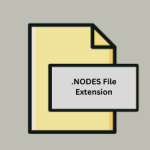.EMD File Extension

ABT Extended Module
| Developer | N/A |
| Popularity | |
| Category | Audio Files |
| Format | .EMD |
| Cross Platform | Update Soon |
What is an EMD file?
The ‘.EMD’ file extension is primarily associated with ABT Extended Module files, which are musical module files commonly used in computer-generated music.
These files contain a collection of instrument samples, patterns, and music data that can be played back by software capable of handling module files, such as trackers and music players.
More Information.
The .EMD file format was developed by ABT as a successor to the more common module file formats like .MOD, .XM, and .IT.
While those formats were popular for creating music on early computer systems, they had limitations in terms of sound quality and instrument capabilities. ABT Extended Modules were designed to address these limitations by introducing a more advanced and flexible format.
The initial purpose of the .EMD file format was to provide a platform for musicians to create high-quality, sample-based music with a wider range of instrument choices. ABT Extended Modules supported advanced features such as high-quality instrument samples, effects, and an improved pattern system.
This made it possible for musicians to produce music with more realistic and diverse sounds.
Origin Of This File.
The origins of the .EMD file extension can be traced back to the tracker music scene of the late 1980s and early 1990s.
Trackers are software applications that allow musicians to compose music by arranging samples and patterns on a grid-based interface. ABT (Audio Binary Tracker), the creator of the .EMD file format, developed this file type to extend the capabilities of traditional module files.
File Structure Technical Specification.
The .EMD file format has a well-defined structure that includes various sections:
- Header: The header section contains metadata about the module, including information about the number of channels, patterns, and samples used in the module.
- Sample Data: This section stores the actual audio samples used in the module. These samples can be in various formats, including PCM, ADPCM, or other compressed formats, depending on the capabilities of the tracker software.
- Pattern Data: Patterns are the building blocks of tracker music. This section contains information about how samples are arranged and manipulated over time. It includes note data, volume commands, and effects commands.
- Instrument Data: In .EMD files, instruments are created by mapping samples to specific notes and settings. This section defines how each instrument is configured and used within the module.
- Effect Data: ABT Extended Modules support a wide range of effects to manipulate the sound. The effect data section contains information about how and when these effects are applied during playback.
How to Convert the File?
Converting .EMD files to more common audio formats like .MP3 or .WAV can be useful for playback on a wider range of devices and software.
To convert .EMD files, you will need a dedicated converter program or a tracker software that supports exporting to standard audio formats. Here are the general steps:
- Choose a Converter: Search for a reliable .EMD to .MP3 or .WAV converter online. Several free and paid options are available.
- Install and Launch: Download and install the chosen converter software. Launch the program.
- Import .EMD File: Use the software’s interface to import the .EMD file you wish to convert. Follow the on-screen instructions to specify the desired output format and settings.
- Conversion: Initiate the conversion process. The software will process the .EMD file and generate the output in the selected audio format.
- Save the Converted File: Once the conversion is complete, save the converted audio file to your preferred location on your computer.
Advantages And Disadvantages.
Advantages:
- High-Quality Sound: .EMD files support high-quality instrument samples, allowing musicians to create music with realistic and rich soundscapes.
- Flexibility: The format offers flexibility in terms of instrument selection and manipulation, making it suitable for various music genres and styles.
- Advanced Effects: ABT Extended Modules provide a wide array of effects that can be applied to enhance the musical composition, including reverb, delay, and modulation effects.
Disadvantages:
- Limited Software Compatibility: Unlike more common formats like .MP3 or .WAV, .EMD files are not widely supported by mainstream media players, which can make it challenging to play them without specialized software.
- Learning Curve: Creating and editing .EMD files can be challenging for beginners due to the complexity of tracker software and the format itself.
How to Open EMD?
Open In Windows
- Software Identification: Determine which application is needed to open the EMD file. This is often specific to the software that generated the file.
- Installation: Download and install the identified software.
- Opening the File: Right-click on the EMD file, select “Open with,” and choose the installed software. If the application is the default for EMD files, double-clicking should open it.
Open In Linux
- Linux Applications: Seek out Linux applications capable of opening .EMD files. The Linux community often has forums where you can find recommendations for specific file types.
- Wine Program: If the software is only available for Windows, you can use Wine, a program that allows Linux users to run Windows applications.
Open In MAC
- Mac-Specific Software: As with Windows and Linux, you’ll need software that can open .EMD files on macOS. The Mac App Store or online software repositories are good places to start looking.
- Conversion Tools: If direct opening isn’t possible, consider converting the .EMD file to a more common format using conversion tools available for Mac.
Open In Android
- Android Apps: Use the Google Play Store to find apps that can handle .EMD files. The availability of such apps can vary, so you might need to research or try out a few different options.
- File Managers: Some advanced file managers for Android might offer the capability to open or view .EMD files.
Open In IOS
- iOS Compatible Apps: Check the Apple App Store for apps that can open .EMD files on iOS devices. The specific type of .EMD file you have might dictate which apps can open it.
- Cloud-Based Tools: Some cloud services might offer tools to view or convert .EMD files, which can then be accessed via their iOS apps.
Open in Others
- For Other Operating Systems: The process varies significantly depending on the OS. For less common operating systems, you may need to rely on universal file viewers or converters, or seek out niche applications tailored to those systems.
- Online Forums and Communities: For platforms where opening .EMD files is uncommon, online forums dedicated to those systems or to .EMD files in general may provide valuable insights and resources.













